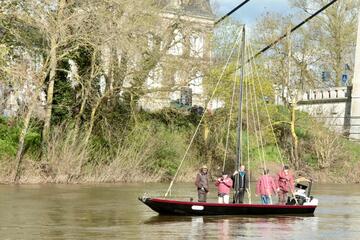
09/04/2024
[Fr] L'Alose, une plate de Loire remise à l'eau à Chalonnes-sur-Loire
Samedi 30 mars, le quartier des mariniers était en liesse. Ils étaient nombreux à avoir répondu à l’invitation des Chalandoux du 5ᵉ Vent pour accompagner...
Published on 10 June 2011 - Updated 20 June 2011
Cet article date d'il y a plus de 12 ans
On Friday 27 May 2011, some hundred people attended the day organised by Mission Val de Loire in partnership with InterLoire and the Loir-et-Cher Chamber of Agriculture. Local authority officials and tourism and viticulture professionals had an opportunity to acquaint themselves with the experience that Val de Loire and its World Heritage vineyards have had in the matter (Vititour network).
In 2000, Val de Loire was listed as a “cultural landscape”, an expression of the interaction between mankind and nature. There can be no doubt that its vineyards are the landscapes in which human work and know-how in nature’s realm are made most manifest. Vineyards cover 15% of the Val de Loire World Heritage site. This being so, their preservation is a top priority.
Two realities threaten our viticultural landscapes: a weakened economic sector and uncontrolled urbanisation developing to the detriment of rural areas.
The Fontevraud International Charter, created in 2003 at the initiative of Mission Val de Loire and the Loire wines Interprofessional organisation, seeks to mobilise local authorities and economic players to protect these landscapes. It aims to make them better known, preserve them and promote them, relying on voluntary approaches that bring representatives of the viticultural sector together with other local players, local authorities, State departments, and tourism and culture professionals.
The concern to preserve viticultural landscapes is shared by all of Europe’s World Heritage sites; in 2005, an initial European project, Vitour, brought together 7 vineyards listed as World Heritage sites by UNESCO. In 2009, 4 more viticultural sites were added, each of them bearing witness to Europe’s age-old cultivation of the vine.
There are a variety of solutions, each adapted to the area concerned:
All experiments had one point in common, the need for partnerships between tourism service providers and transporters.
Three innovative experiments were presented:
Buildings are an important feature of viticultural landscapes (farm buildings, wine storehouses, vineyard lodges, dry stone walls, etc.). Preserving significant heritage, rehabilitating existing buildings or constructing new ones while conserving the spirit of the place, is a major priority.
One example is the Cheverny Wine House, which is accommodated in one of Château de Cheverny’s outbuildings and provides innovative services (self-service wine tasting with RFID chips).
In 2009,The town of Montlouis-sur-Loire, in collaboration with the Côtes de Montlouis Viticultural Union, set up a Zone Agricole Protégée (ZAP – Protected Agricultural Area) with a view to ensuring that winegrowers ran no risk of losing their farms by prohibiting urbanisation in reserved sectors. The town also envisages a partnership with the Versailles School of Landscaping to highlight these landscapes which add so much to the Appellation’s appeal and celebrity.
Although winegrowing estates were initially seen in purely economic terms, regional policies now take their tourist appeal fully into account.
The success of oenotourism in Val de Loire is due to development of a widespread and highly diversified offer, professionalisation of players in the viticultural sector, and work in partnership with tourist operators.
Tourism brings an outside view, enabling us to see our territory from a fresh angle, and helping us to be more sensitive to a landscape recognised as being of exceptional global worth by UNESCO.
Bien reçu !
Nous vous répondrons prochainement.
L’équipe de la Mission Val de Loire.